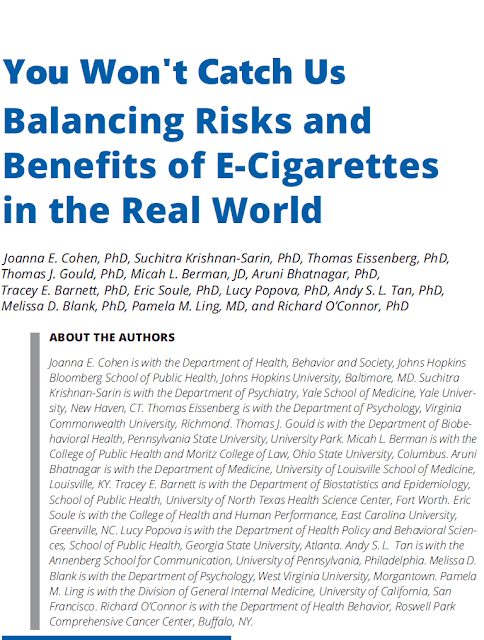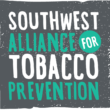
Dr. Joanna Cohen recently authored a misleading and
factually incorrect commentary
on tobacco harm reduction in The Hill.
Here is my rebuttal, in bold.
Cohen: “So why should we trust cigarette companies to help
reduce tobacco use?”
No one trusts cigarette companies. That’s why Congress gave the Food and Drug
Administration regulatory authority over tobacco in 2009. Cohen misrepresents the principle public
health goal, which isn’t to reduce tobacco use, but to prevent the 480,000
premature American deaths that result each year from smoking. That number
hasn’t appreciably changed for the 15 years the FDA has had regulatory
authority.
Cohen: “For the last several years, the tobacco industry has
been co-opting the term ‘harm reduction’ from public health, using it to frame
electronic devices and e-cigarettes as the be-all, end-all of smoking cessation
tools.”
False. Harm
reduction wasn’t co-opted, because Cohen and most public health officials never
applied it to tobacco. They insisted
that smokers quit only through total nicotine and tobacco abstinence. Conversely, cigarette manufacturers did
ultimately acknowledge that their products were deadly, and that there were
vastly safer smoke-free ways to consume nicotine. In the mid-2000s, they
started acquiring smokeless tobacco companies, which produced those safer
products, and more recently, pushed by disruptive technology and new
competitors, they adopted vapor
and heat-not-burn
tobacco products, which are also significantly safer than cigarettes.
Cohen and company are the only ones calling e-cigarettes
“the be-all, end-all of smoking cessation tools.” They seemingly forget that only 5% of all smokers
achieve nicotine/tobacco abstinence in any given year.
Cohen: “Such [harm reduction] methods include restricting
tobacco advertising and promotion, increasing the price of tobacco products,
and establishing 100 percent smoke-free public spaces. These all support people
who are ready to quit without requiring abstinence.”
How do those steps support people who are ready to quit
without requiring nicotine abstinence?
Cohen merely recycles failed measures that limit smokers’ options of ‘quit
or die.’
Cohen: “It is critically important, however, to note that,
to date, no company in the U.S. has sought out FDA authorization to market
these products as approved cessation devices.”
No, it’s not. Authorization
as a cessation device would not be handled by the FDA tobacco center, but by
the drugs or medical device centers. The
FDA approved nicotine medications decades ago, even though, to meet FDA
requirements for approval, they’re expensive and ineffectively low-dose, require
warnings far greater than those on cigarettes, and don’t provide the nicotine
spike that smokers get when they light up.
With a regulatory framework like this, no wonder nicotine
medications are successful for only about 7% of smokers who try them.
For what other medications does the FDA accept a 93% failure rate? Let alone medications to treat a condition
that will unnecessarily
kill 480,000 Americans this year. It is outrageous that the agency and most of
the public health community promotes this failed strategy when safer, popular
harm reduction tools are readily at hand.
Cohen: “…enabling tobacco to remain the leading preventable
cause of death around the world.”
Cohen
knows that tobacco
is not a synonym for smoke, but she repeats the egregious
conflation, proving again she chooses to ignore that nicotine is the
reason people smoke, but not the reason that smokers die.
Cohen: “tobacco industry allies baselessly position
e-cigarettes and heated tobacco products as the only viable harm reduction
method for people who want to stop smoking. They discount existing FDA-approved
cessation methods entirely.”
This statement is full of falsehoods. Tobacco harm reduction proponents
are not industry allies; they are allies of those 480,000
smokers who will die prematurely this year. The FDA-approved cessation methods Cohen et
al. diss have only a woeful 7% percent success rate, as noted above. Many other alternatives to cigarettes are already
available, and many others are under development.
Cohen: “…we know that nicotine can still be
extremely addictive.”
Yes, nicotine can be addictive, which
is why her goal of nicotine-and-tobacco abstinence is so misguided. Harm reduction proponents recognize that many
smokers cannot achieve Cohen’s abstinence nirvana, so they promote practical solutions
that save lives.
Cohen: “a whole new generation of consumers, including
children and young people enticed by appealing flavors, who may spend the rest of their lives trying to curb a
nicotine addiction.”
Everyone shares Cohen’s concern for children, and society
should discourage them from adopting dangerous adult behaviors. If Cohen was consistent, however, she would
call for sanctions on companies selling alcohol, which poses a far
greater threat to teen health, and she would focus on marijuana, used
by 25 percent of all teens over the past 30 years.
Cohen worries that teens “may spend the rest of their
lives trying to curb a nicotine addiction,” but nicotine is no more dangerous
than caffeine, another addictive substance.
Cohen’s prescription – a ban on nicotine and tobacco – is doomed to
fail, just as the complete ban on marijuana use failed for 30 years.
Cohen: “This playbook isn’t new. For decades,
the tobacco industry refused to acknowledge that cigarettes are deadly…”
Actually, the playbook changed
dramatically, as cigarette manufacturers now acknowledge that combustible
products kill. But by denigrating safer
tobacco products, Cohen et al. prolong
cigarettes’ dominance of the tobacco/nicotine market.
In summary, do not mistake Cohen’s
distorted idea of harm reduction as anything more than cigarette market
prolongation.




